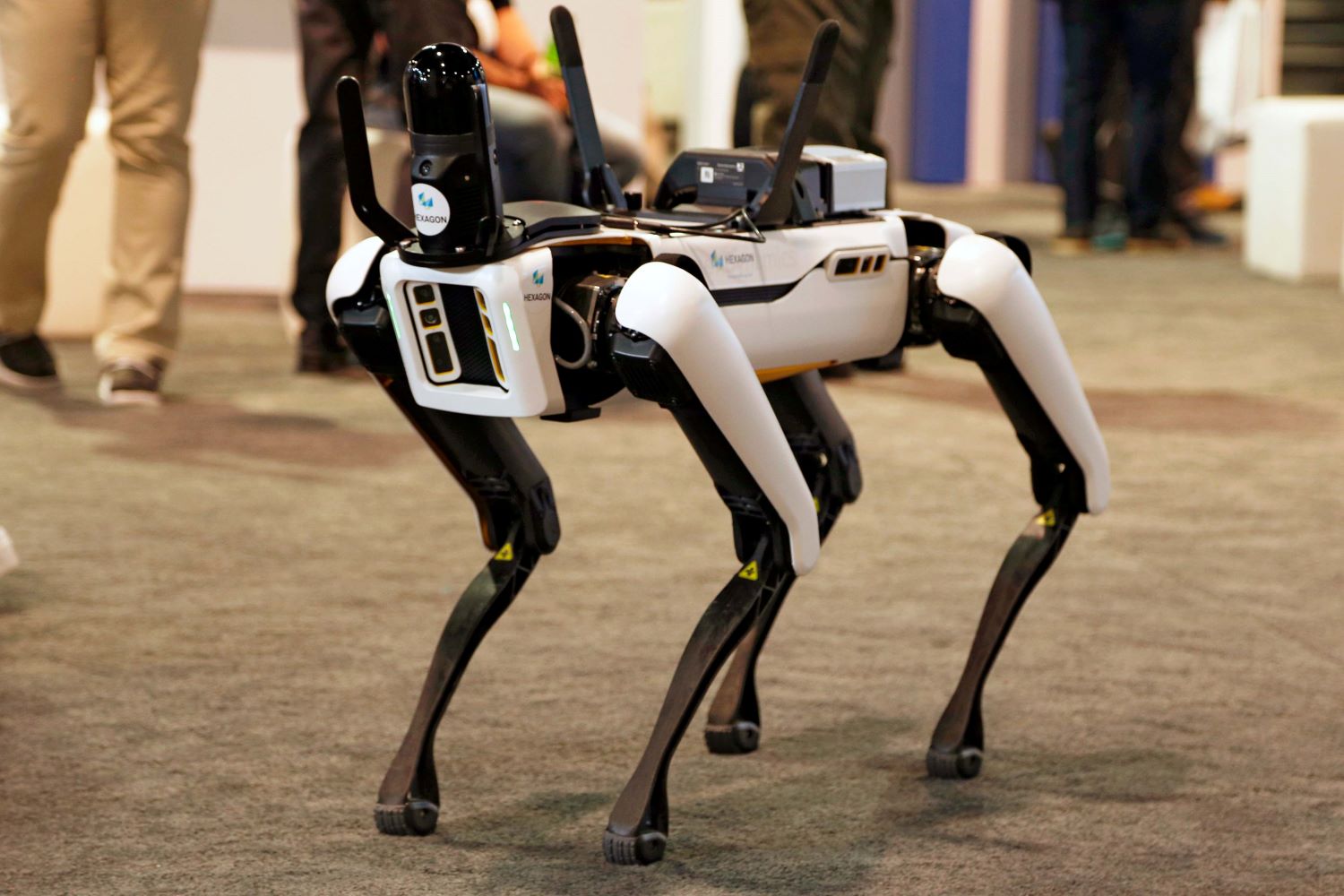The rise of the robo-crew on construction sites
A revolution is brewing on construction sites, driven by advancements in robotics. It started to happen big time in 2020 and just four years later it is becoming a reality where tireless robots navigate treacherous terrains, collect crucial data and even assist with material delivery. This future is closer than you think and it's being shaped by innovative robots like the SPOT by Boston Dynamics, writes John Ridgeway.
If you feel the “Terminator” really has arrived, then check out the YouTube link at the bottom of this blog – the SPOT robot really is the future – and the technology is reacting well alongside human workers.
Essentially, the SPOT robot is a quadruped marvel, boasting an agile design that allows it to conquer uneven surfaces, climb stairs and traverse challenging environments. Unlike traditional wheeled robots that struggle with rough terrain, SPOT thrives in the dynamic world of construction sites. This unique mobility makes it a valuable asset, offering a range of potential applications,
It is equipped with high-resolution cameras and LiDAR sensors and can perform autonomous site inspections. It can also capture detailed 3D models of the construction area, identify potential safety hazards and even document progress for future reference. This reduces the need for human workers to enter potentially dangerous areas.
SPOT can be equipped with various sensors to gather environmental data such as air quality, dust levels and noise pollution. This real-time data is crucial for ensuring worker safety and compliance with environmental regulations. It can also be equipped with specialised attachments to transport materials across a construction site. This can be particularly beneficial for delivering small but essential supplies to various locations, freeing up human workers for more complex tasks and reducing the risk of strain injuries.

A proven ally on construction sites
Since its introduction, the SPOT robot has transitioned from a promising concept to a proven asset on construction sites. Its agile design and adaptability continue to make it a valuable tool, with ongoing developments and real-world applications:
Boston Dynamics continues to refine SPOT's capabilities. New software and hardware upgrades may include improved obstacle detection, better weather resistance and increased payload capacity. This allows SPOT to tackle a wider range of tasks and operate in more challenging environments.
As a result, construction companies are exploring new ways to utilize SPOT. In 2024, we might see this incredible robot used for tasks such as automated rebar tying. This is a repetitive task and would help to reduce worker strain and improve efficiency. SPOT's small size and manoeuvrability also makes it ideal for inspecting tight spaces or hazardous environments, minimising risk to human workers.
Robots are here to stay
The number of construction companies embracing robotic technology is on the rise. Skanska USA is piloting a programme using SPOT robots for automated data collection and progress monitoring on a bridge construction project in California. Real-time data from SPOT helps project managers identify potential issues and make informed decisions.
In Australia, Lendlease is exploring the use of SPOT robots for security patrols on large construction sites. SPOT's ability to navigate autonomously at night deters potential theft and vandalism, improving overall site security.
Turner Construction Company has piloted the use of SPOT robots on a Boston job site. The robot was tasked with autonomously navigating the site, capturing data, and providing real-time visualisations of progress. This pilot programme showcased the robot's ability to enhance data collection and improve project monitoring.
Bam Nuttall Ltd, a UK-based contractor, has been using SPOT robots for site inspections and data collection on various construction projects. Their experience highlights the robot's agility and potential to improve safety and efficiency.
Humans and robots working together
While the potential of robots in construction is undeniable, wider integration will require a collaborative approach. Industry standards and regulations are evolving to address the safe use of robots on construction sites. These regulations will ensure the well-being of both human workers and those interacting with the robots.
As the industry embraces robots, construction companies are also investing in training programmes to equip workers with the necessary skills to collaborate effectively with robots. This may involve learning to operate robots, analyse data and understand robot safety protocols.
Furthermore, open communication and a focus on reskilling workers for new roles alongside robots will be crucial for a smooth transition – and there is an added bonus - the construction industry can leverage the adoption of robots as an opportunity to create new, high-tech jobs.
The road ahead
Whether we like it or not, the future of construction is about humans and robots working together to build a better tomorrow. SPOT robots and similar advancements represent a significant step towards:
By performing hazardous tasks such as inspecting precarious areas or collecting data from unsafe environments, SPOT robots can significantly reduce the risk of worker injuries. This translates to a safer work environment and peace of mind for construction crews.
SPOT, as already discussed, can automate repetitive tasks like site inspections and material delivery, freeing up valuable time for human workers. This allows them to focus on more complex activities that require human ingenuity and problem-solving skills.
The data collected by SPOT robots also provides valuable insights into project progress, environmental conditions and potential safety hazards. This data empowers construction companies to make informed decisions, optimise workflow, and ultimately improve project outcomes.
Expanding the Robo-Crew
SPOT robots represent just one facet of a broader trend towards automation in construction. As the technology matures and becomes more cost-effective, we can expect a wider range of robots specifically designed for construction tasks.
As we can see from the Australian experience, robots can be programmed to patrol construction sites at night, deterring theft and vandalism. This can improve overall security and reduce costs associated with traditional security measures.
SPOT can also be equipped with systems to track and manage construction materials on-site. This can streamline inventory management, minimise material loss and ensure workers have the supplies they need readily available.
In addition, real-time data and video feeds from SPOT robots can facilitate remote collaboration between project managers, engineers and other stakeholders. This allows for better communication, faster decision-making and improved oversight of projects.
The Road Ahead: A Human-Robot Collaboration
The future of construction is not about robots replacing human workers; it's about human-robot collaboration. SPOT robots and similar advancements are not designed to take over construction jobs, but rather to augment human capabilities and create a safer, more efficient and data-driven construction environment.
The construction industry is on the cusp of a transformative era. By embracing innovative technologies like SPOT robots and fostering a collaborative approach between humans and robots, we can build a safer, more efficient, and sustainable future for construction. As the industry evolves, continuous learning, adaptation and a commitment to safety will be paramount in navigating this exciting new frontier.
Sources:
- Boston Dynamics Website: https://bostondynamics.com/products/spot/
- https://www.youtube.com/watch?v=wND9goxDVrY
- Boston Dynamics Website: https://bostondynamics.com/products/spot/
- "Advancing Robotics In Construction With Spot" (YouTube Video): https://www.youtube.com/watch?v=wND9goxDVrY
- "How is Spot the robot dog being used on construction sites?" (Construction Briefing Article): https://newatlas.com/architecture/spot-robot-dog-foster-partners-boston-dynamics/
- "Construction Robotics: The Future of Building?" (Engineering.com Article): https://www.linkedin.com/pulse/robotics-construction-industry-2022-use-benefits-types-reetie-multani
- https://newatlas.com/architecture/spot-robot-dog-foster-partners-boston-dynamics/
Additional Blogs

How construction can cut Its carbon footprint by caring for soil
Soil is often dismissed as mere dirt, but it is one of the planet’s most powerful carbon stores, holding more than all of the world’s forests combined. Yet in our rush to build, pave and develop, we...
Read moreWhat is bridging damp? How it happens and how to fix it
Bridging damp happens when moisture finds a path around the building’s damp-proof course (DPC) so it reaches your internal walls and skirting. If you see damp patches rising above the skirting or...
Read more

The silent death of the fixed-price contract
For decades, the fixed-price contract has been the backbone of construction procurement. It promised certainty with a defined scope, an agreed sum and a clear transfer of risk from client to...
Read more